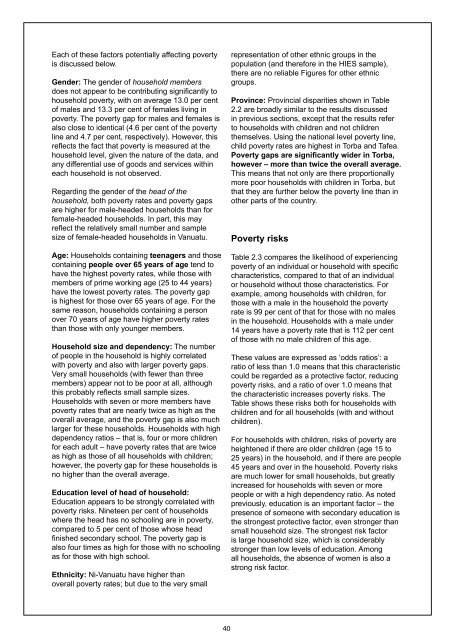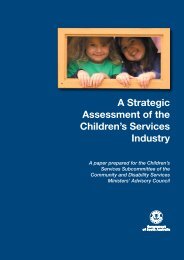Global Study On Child Poverty And Disparities (PDF) - Social Policy ...
Global Study On Child Poverty And Disparities (PDF) - Social Policy ...
Global Study On Child Poverty And Disparities (PDF) - Social Policy ...
Create successful ePaper yourself
Turn your PDF publications into a flip-book with our unique Google optimized e-Paper software.
Each of these factors potentially affecting poverty<br />
is discussed below.<br />
Gender: The gender of household members<br />
does not appear to be contributing significantly to<br />
household poverty, with on average 13.0 per cent<br />
of males and 13.3 per cent of females living in<br />
poverty. The poverty gap for males and females is<br />
also close to identical (4.6 per cent of the poverty<br />
line and 4.7 per cent, respectively). However, this<br />
reflects the fact that poverty is measured at the<br />
household level, given the nature of the data, and<br />
any differential use of goods and services within<br />
each household is not observed.<br />
Regarding the gender of the head of the<br />
household, both poverty rates and poverty gaps<br />
are higher for male-headed households than for<br />
female-headed households. In part, this may<br />
reflect the relatively small number and sample<br />
size of female-headed households in Vanuatu.<br />
Age: Households containing teenagers and those<br />
containing people over 65 years of age tend to<br />
have the highest poverty rates, while those with<br />
members of prime working age (25 to 44 years)<br />
have the lowest poverty rates. The poverty gap<br />
is highest for those over 65 years of age. For the<br />
same reason, households containing a person<br />
over 70 years of age have higher poverty rates<br />
than those with only younger members.<br />
Household size and dependency: The number<br />
of people in the household is highly correlated<br />
with poverty and also with larger poverty gaps.<br />
Very small households (with fewer than three<br />
members) appear not to be poor at all, although<br />
this probably reflects small sample sizes.<br />
Households with seven or more members have<br />
poverty rates that are nearly twice as high as the<br />
overall average, and the poverty gap is also much<br />
larger for these households. Households with high<br />
dependency ratios – that is, four or more children<br />
for each adult – have poverty rates that are twice<br />
as high as those of all households with children;<br />
however, the poverty gap for these households is<br />
no higher than the overall average.<br />
Education level of head of household:<br />
Education appears to be strongly correlated with<br />
poverty risks. Nineteen per cent of households<br />
where the head has no schooling are in poverty,<br />
compared to 5 per cent of those whose head<br />
finished secondary school. The poverty gap is<br />
also four times as high for those with no schooling<br />
as for those with high school.<br />
Ethnicity: Ni-Vanuatu have higher than<br />
overall poverty rates; but due to the very small<br />
representation of other ethnic groups in the<br />
population (and therefore in the HIES sample),<br />
there are no reliable Figures for other ethnic<br />
groups.<br />
Province: Provincial disparities shown in Table<br />
2.2 are broadly similar to the results discussed<br />
in previous sections, except that the results refer<br />
to households with children and not children<br />
themselves. Using the national level poverty line,<br />
child poverty rates are highest in Torba and Tafea.<br />
<strong>Poverty</strong> gaps are significantly wider in Torba,<br />
however – more than twice the overall average.<br />
This means that not only are there proportionally<br />
more poor households with children in Torba, but<br />
that they are further below the poverty line than in<br />
other parts of the country.<br />
<strong>Poverty</strong> risks<br />
Table 2.3 compares the likelihood of experiencing<br />
poverty of an individual or household with specific<br />
characteristics, compared to that of an individual<br />
or household without those characteristics. For<br />
example, among households with children, for<br />
those with a male in the household the poverty<br />
rate is 99 per cent of that for those with no males<br />
in the household. Households with a male under<br />
14 years have a poverty rate that is 112 per cent<br />
of those with no male children of this age.<br />
These values are expressed as ‘odds ratios’: a<br />
ratio of less than 1.0 means that this characteristic<br />
could be regarded as a protective factor, reducing<br />
poverty risks, and a ratio of over 1.0 means that<br />
the characteristic increases poverty risks. The<br />
Table shows these risks both for households with<br />
children and for all households (with and without<br />
children).<br />
For households with children, risks of poverty are<br />
heightened if there are older children (age 15 to<br />
25 years) in the household, and if there are people<br />
45 years and over in the household. <strong>Poverty</strong> risks<br />
are much lower for small households, but greatly<br />
increased for households with seven or more<br />
people or with a high dependency ratio. As noted<br />
previously, education is an important factor – the<br />
presence of someone with secondary education is<br />
the strongest protective factor, even stronger than<br />
small household size. The strongest risk factor<br />
is large household size, which is considerably<br />
stronger than low levels of education. Among<br />
all households, the absence of women is also a<br />
strong risk factor.<br />
40
















